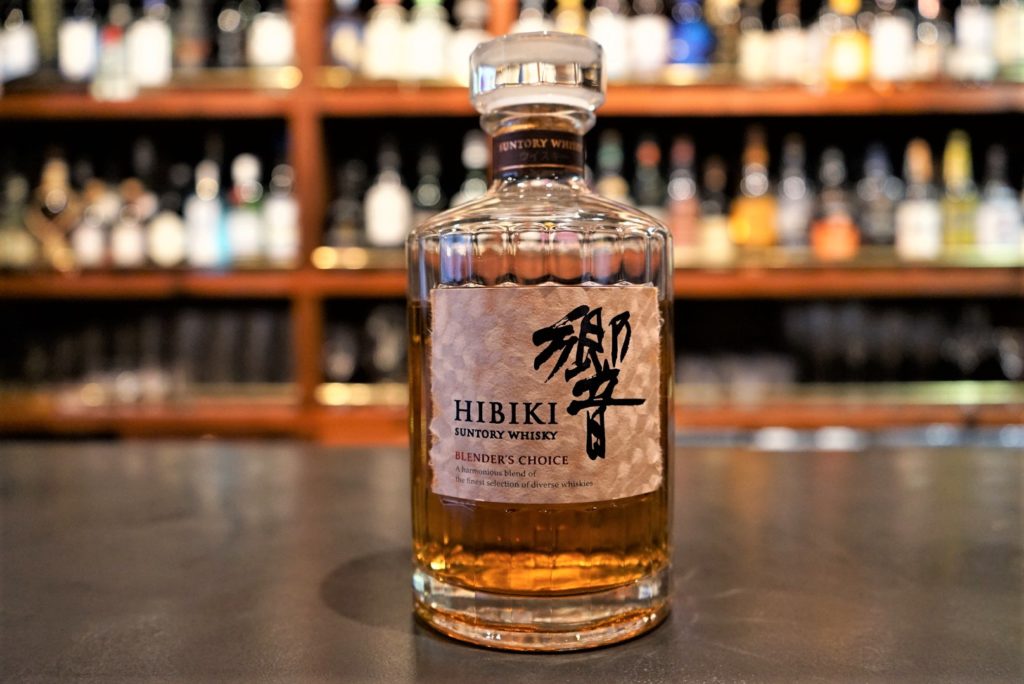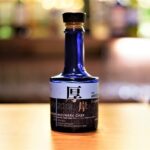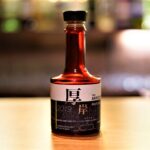Released in September 2018 as the successor line to Hibiki 17 Year.
It is said to have an average age of 15 years, with some parts of it made from long term aged raw materials that exceed 30 years. It has a mellow and deep taste.
1. Manufacturer
Suntory Spirits Co.
| Established | 1899 |
| Headquarters Location | 2-3-3 Daiba, Minato-ku, Tokyo 135-8631, Japan |
| Owned distillery | ●Japan Yamazaki Distillery, Hakushu Distillery, Chita Distillery ●Scotland Ardmore distillery, Glengilly distillery, Auchentoshan distillery, Bowmore distillery, Laphroig distillery ●Ireland Cooley distillery, Kilbeggan distillery ●United States Jim Beam distillery, Maker’s Mark distillery ●Canada Hiram Walker distillery, Alberta distillery |
2. distillery
“The raw materials that make up the deep flavors of Hibiki are nurtured at Suntory’s three distilleries. The Yamazaki Distillery was built in Yamazaki, Kyoto, a place that boasts of its famous water. The malt liquor born in this humid place, where the three rivers Uji, Katsura and Kizu converge, has a gorgeous and elegant flavor.
The Hakushu Distillery is located in Yamanashi, embraced by Mount Kai Komagatake. The malt liquor produced in the forest, which is rare in the world, has a light mouthfeel and a refreshing aroma.
The grain, which is the keystone of the blended whisky flavor, enhances the character of the malt and brings the whole into harmony. It is produced at the Chita Distillery on the Chita Peninsula in Aichi Prefecture, overlooking Ise Bay.
Suntory Yamazaki Distillery
| Location | 5-2-1 Yamazaki, Shimamoto-cho, Mishima-gun, Osaka 618-0001, Japan |
| Start of operation | 1923 |
The Yamazaki Distillery was established in 1923 as the first malt whisky distillery in Japan. At a time when whisky was still a rare drink for the general public, Shinjiro Torii set out to create a Japanese whisky that would suit the delicate taste of the Japanese people. With this passion in his heart, Shinjiro Torii set out to make whisky.
Shinjiro was particular about the Japanese climate. Water and the environment were especially important to him. Yamazaki is the home of the famous water called Minase no, which was written about in the Manyo poem.
The tea master Sen no Rikyu loved this place and the water was perfect for making whisky. The natural environment was also perfect.
Yamazaki is located in the southwest of Kyoto, at the foot of Tennozan (Mt. Tenno), where bamboo groves grow thickly, and is rich in nature where you can feel the seasonal changes. Located at the confluence of the Katsura, Uji, and Kizu Rivers, and surrounded by mountains, Yamazaki is prone to thick fog and has a warm and humid climate, which is ideal for maturing whisky.
“Nobujiro decided to make Yamazaki the home of whisky, saying, “Yamazaki is the only place with this water and climate to make good whisky.
Reference: YAMAZAKI MOMENTS
Suntory Yamazaki Distillery
1923 Yamazaki distillery was built. The first whisky distillery in Japan.
1929 Released the first domestically produced whisky, Shirofuda.
1937 Released “Kakubin”.
1984 Released single malt whisky “Yamazaki”.
1992 – Single malt whisky ” Yamazaki 18 years ” was launched.
1998 – Single malt whisky “Yamazaki 25 years” was launched.
Image courtesy of Yamazaki Club
For more information on the Yamazaki Distillery, please see this article. https://en.jpwhisky.net/manufacturer/yamazaki_en/
Suntory Hakushu Distillery
| Location | 2913-1 Toribaru, Hakushu-cho, Hokuto City, Yamanashi Prefecture, 408-0316, Japan |
| Start of operation | 1973 |
In 1973, exactly 50 years after Japan’s first whisky production, the Hakushu Distillery was completed in a lush forest of 820,000 square meters at the foot of Mount Kai Komagatake in the Southern Alps, blessed with abundant nature.
The brewing water is surrounded by the moist atmosphere of the forest, and the Hakushu malt is made with pure and soft natural water from the Southern Alps, polished by granite. The malt is matured over a long period of time in the changing seasons that are unique to Japan, and is the source of the clean, aromatic Hakushu flavor.
In 2014, the company spent 1 billion yen to add four more pot stills, bringing the total number of stills to 16. A wide variety of pot stills of different sizes and shapes are used to make different types of sake. The storage room is a rack type with a high ceiling. The temperature and humidity are not controlled by hand, but are left to nature.
1973 Hakushu distillery was built.
1994 Release of Hakushu 12 years
2006 Release of Hakushu 18 years
2008 Release of Hakushu 25 years
Image credit: Suntory Official Forest Distillery
For more information about Hakushu Distillery, please see this article. https://jpwhisky.net/manufacturer/hakushu/
Suntory Chita Distillery
| Location | 16 Kitahamacho, Chita City, Aichi Prefecture, 478-0046, Japan |
| Start of operation | 1973 |
The Chita Distillery, located on the Chita Peninsula overlooking Ise Bay, is a grain whisky distillery established by the Suntory Group in collaboration with the Zen-Noh Group, and is one of the three domestic whisky distilleries of the Suntory Group, along with the Yamazaki and Hakushu distilleries for malt whisky. Here, corn-based grain whisky has been supported. The Chita Distillery uses continuous distillation to produce three types of grain whisky: clean, medium and heavy, which is unique in the world.

Image source: What is Suntory Whisky “Chita”?
3. Product name and photo
Hibiki Blender’s Choice

4. Characteristics
A harmony of sweetly resonant, diverse raw materials and master craftsmanship
The taste of whisky changes greatly depending on the cask in which it is laid down, and the most commonly used cask is bourbon, sherry, and Japanese oak. In general, wine barrels have a strong sense of oddity, but whiskys that have been laid down in wine barrels often have a fruity and sweet taste, which creates a mellow and sweet taste and a well-balanced flavor even if the aging period is short.
4-1. Tasting Notes
| Aroma | Wild strawberry, white peach, pineapple, crème brûlée |
| Taste | Plump sweetness, pleasant acidity |
| Aftertaste | Soft and sweet with a bittersweet aftertaste. |
4-2. Product Specifications
| Alcohol content | 43% alcohol by volume |
| alcohol category | blended whisky |
| Barrel type | Bourbon barrels, sherry barrels, Quercus serrata barrels, wine barrels |
| Contents | 700ml |
| Number of bottles sold | – |
| Suggested retail price | 11,000 yen (tax included) |
| Release date | September, 2018 |
5. Award history
No awards have been received at this time.
6. Price
6-1. Manufacturer’s suggested retail price

| Product name | Hibiki Blender’s Choice |
| Capacity | 700ml |
| Suggested Retail Price | Tax included: 11,000 yen |
6-2. Resale price on Mercari
The resale price on Mercari is around 10,000 yen to 15,000 yen. (*As of April 19, 2021)


6-3. Yahoo auction bidding price
The current prices on Yahoo Auction are as follows: Lowest price: 8,000 yen, Highest price: 17,800 yen, Average price: 11,174 yen(*as of April 19, 2021)

6-4. Rakuten, Yahoo Shopping, Amazon
You can find them on mail order sites for around 12,000 yen to 15,000 yen. (*As of April 19, 2021)
6-5. Price offered at BAR SHINKAI
At “BAR SHINKAI”, which is operated by our website, we offer even small amounts such as 1 glass, 45ml: 3,300 yen, 30ml: 2,200 yen, 15ml: 1,100 yen.
https://en.jpwhisky.net/about-2/barshinkai-4/
7. Summary
The body is medium to light. The body is medium to light, and you can feel a little alcohol from the young sake, but not to the point of disgust. When it was first released, it was not sold to the general public, but was sold only at business stores (restaurants).
I feel that it is a Japanese blended whisky that is worth drinking even if you consider the regular price. It has a taste that is easy to drink for whisky beginners and women, but also has a good balance that whisky lovers can enjoy, which is truly the boundary of blended whisky.
Please check out the other articles about Hibiki.
https://en.jpwhisky.net/2021/01/27/suntoryhibiki21year-2/
https://en.jpwhisky.net/2019/01/24/hibiki-japaneseharmony-2/
Lastly: Recommended Books on Japanese Whisky
If you want to learn more about Japanese whisky, which is a global trend, we highly recommend these books.
(1).Whisky Galore Vol.29 December 2021 issue
In the December 2021 issue of Whisky Galore, published by the Whisky Culture Research Institute, we report on 11 Japanese craft distilleries, including some that are open to the public for the first time, under the title of “Japanese Whisky Craft Frontline,” the first of three consecutive issues. Why did the popularity of Japanese whisky and the craft boom occur? We will examine with interviews. Chichibu Distillery / Chichibu No.2 Distillery / Mars Shinshu Distillery / Mars Tsunuki Distillery / Kanosuke Distillery / Hioki Distillery / Ontake Distillery / Osuzuyama Distillery / Kaikyo Distillery / Hanyu Distillery / Konosu Distillery
(2). Japanese Whisky as an Education for Business
This is a book written by Mamoru Tsuchiya, a world-famous whisky critic and representative of the Whisky Culture Research Institute, titled “Japanese Whisky as a Culture that Works for Business” .
The book covers the basics of whisky, the introduction of whisky to Japan, the birth of Japanese whisky, advertising strategies and the rise of Japanese whisky, and the current rise of craft distilleries. This is a book that summarizes Japanese whisky in a very easy to understand way.
(3). Whisky and I (Masataka Taketsuru)
Masataka Taketsuru, the founder of Nikka Whisky, devoted his life to brewing whisky in Japan. This is a revised and reprinted version of the autobiography of a man who simply loved whisky and talked about himself. The book vividly depicts the days when he went to Scotland alone to study as a young man and overcame many hardships to complete Japanese whisky, as well as his companion, Rita.
(4). A Letter of Challenge from a New Generation Distillery
Launching in 2019. With the world experiencing an unprecedented whisky boom, what were the managers of craft distilleries thinking and what were their thoughts as they took on the challenge of making whisky? This book tells the stories of 13 craft distillery owners, including Ichiro Hido of Venture Whisky, famous for his Ichirose Malt, who inspired the birth of craft distilleries in Japan.
(5). Whiskey Rising
This is the Japanese version of Whisky Risng, published in the US in 2016, with much updated content. Not only does it describe the history of Japanese whisky in detail, but it also includes data on all the distilleries in Japan, including the craft distilleries that have been founded in recent years. The book also includes descriptions of the legendary bottles that have been released, as well as information on bars where Japanese whisky can be found.







